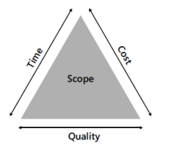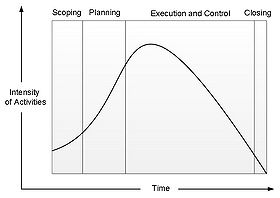Scheduling techniques in Project Management
| Line 23: | Line 23: | ||
==Five Steps in Project Management== | ==Five Steps in Project Management== | ||
[[File:Activities.jpg| 280px|thumb|right|Five Steps in the Project Management according the PMI®]] | [[File:Activities.jpg| 280px|thumb|right|Five Steps in the Project Management according the PMI®]] | ||
| − | # Scoping
| + | |
| + | # Scoping
: | ||
This phase answers the question: “'''What shall be done?'''”. First of all the output of the project has to be something that reflects the needs of a specific target costumers. Afterwards the draft of the scope, it’s necessary to make sure that all the needed resources are on board to start with the project. | This phase answers the question: “'''What shall be done?'''”. First of all the output of the project has to be something that reflects the needs of a specific target costumers. Afterwards the draft of the scope, it’s necessary to make sure that all the needed resources are on board to start with the project. | ||
| − | # Planning | + | # Planning: |
The question for this step is “'''How are we going to do it?'''”. It’s crucial to define all the activities that must be done for the project. A valuable tool to do this is the WBS (Work Breakdown Structure). Defining the people, creating the project team, estimating costs and time is the heart of the Project Management. | The question for this step is “'''How are we going to do it?'''”. It’s crucial to define all the activities that must be done for the project. A valuable tool to do this is the WBS (Work Breakdown Structure). Defining the people, creating the project team, estimating costs and time is the heart of the Project Management. | ||
PERT (program (or project) evaluation and review technique) and Gantt Diagram are two important tools to analyze into details each step of the project to find out the time to reach its conclusion. | PERT (program (or project) evaluation and review technique) and Gantt Diagram are two important tools to analyze into details each step of the project to find out the time to reach its conclusion. | ||
| − | # Executing and controlling | + | # Executing and controlling: |
These are two phases that can be run simultaneously: the first one refers to the execution of the planned work whereas the second one checks if the actual development of the work is on line with the planned one. If there are gaps between these latest there must be additional planifications. | These are two phases that can be run simultaneously: the first one refers to the execution of the planned work whereas the second one checks if the actual development of the work is on line with the planned one. If there are gaps between these latest there must be additional planifications. | ||
This big step is extremely important because it covers the launch of the project till its end. | This big step is extremely important because it covers the launch of the project till its end. | ||
Revision as of 09:49, 12 September 2015
“The Project Management is a management system that aims to results”.[1] The goal of a project can only be reached through precise scheduling techniques that take into account all various constraints such as time and economic resources. Techniques such as PERT, CPM and GANTT are the most used to plan into details a project, prevent uncertainties and avoid risk. These three techniques complete each other and offer a wide range of scenario that could occur during the development of a project The aim of the scheduling techniques is to reach the goal on time without wasting precious and limited resources. On the other hand it’s an important tool to prevent in advance future situations and to promptly identify future issues that can compromise the success of the project. Thought the use of these techniques all the single steps of a project are defined in advance, the goals are clear and the resources are properly allocated.
Introduction to the Project Management
“A project is a sequence of unique, complex, and connected activities that have one goal or purpose and that must be completed by a specific time, within budget, and according to specification.” [2] Every project has therefore constraints that can be summed up into the Project Management Triangle.
Every project has therefore constraints that can be summed up into the Project Management Triangle. The most important interlinked constraints of a project are: time, cost and quality. Figure XX shows that the value of two constraints, they determine the third one. For example, you can build a house quickly with a really high quality but it will cost heaps. On the other hand, you can choose to save up and reduce costs and build it in short time but the quality won’t be excellent. Through this example, it can be understood that projects has to deal with limitations and with compromises. Managing and supervising a project is not an easy job and its management is the crucial issue. "The Project Management is the application of knowledge, attitudes, techniques and tools to the activities that form a project to reach successfully the goals." [3]
According to the PMI® - Project Management Institute there are five steps to determine the entire managing flow of the process from the beginning to the end:
- 1. Scoping
- 2. Planning
- 3. Executing
- 4. Controlling
- 5. Closing
Five Steps in Project Management
- Scoping :
This phase answers the question: “What shall be done?”. First of all the output of the project has to be something that reflects the needs of a specific target costumers. Afterwards the draft of the scope, it’s necessary to make sure that all the needed resources are on board to start with the project.
- Planning:
The question for this step is “How are we going to do it?”. It’s crucial to define all the activities that must be done for the project. A valuable tool to do this is the WBS (Work Breakdown Structure). Defining the people, creating the project team, estimating costs and time is the heart of the Project Management. PERT (program (or project) evaluation and review technique) and Gantt Diagram are two important tools to analyze into details each step of the project to find out the time to reach its conclusion.
- Executing and controlling:
These are two phases that can be run simultaneously: the first one refers to the execution of the planned work whereas the second one checks if the actual development of the work is on line with the planned one. If there are gaps between these latest there must be additional planifications. This big step is extremely important because it covers the launch of the project till its end.
- Closing:
It includes all the necessary activities for the closure of the project. Here the question could be: “How well did the project go?”. At this step it’s important to analyze the acceptance of the good/service from the customers, to investigate how was the management of the project, its pros and cons and some possible improvements. The lasts thing that belongs to this phase is the communication to all the stakeholders about the conclusion of the project and the reached goals.
The step is going to be analyzed in this article is the Planning. Scheduling techniques are extremely important to plan into details how the project is going to be developed. It’s nearly impossible to make decisions about a project without any scheduling tools. They are fundamental to avoid as much as possible risk and uncertainty. They are really helpful to have a wide view of all the different scenarios that could occur.
REFERENCES
- ↑ Miscia S., 1994, Il Project Management, Quaderni di Formazione Pirelli, Milano.
- ↑ Robert K. Wysocki, 2009, Effective Project Management: Traditional, Agile, Extreme. Fifth Edition. [Available online on Google books] pag. 6 https://books.google.it/books?id=AQifszBiJe8C&pg=PA6&lpg=PA6&dq=“A+project+is+a+sequence+of+unique,+complex,+and+connected+activities+that+have%E2%80%A8one+goal+or+purpose+and+that+must+be+completed+by+a+specific+time,+within%E2%80%A8budget,+and+according+to+specification.”+reference&source=bl&ots=vxN9JNFKlB&sig=0CWyn9uoUdxCWrP8bH2Db56BbPQ&hl=it&sa=X&ved=0CEIQ6AEwBGoVChMIzd6u-ovxxwIVircUCh0YgQKk#v=onepage&q=“A%20project%20is%20a%20sequence%20of%20unique%2C%20complex%2C%20and%20connected%20activities%20that%20have%E2%80%A8one%20goal%20or%20purpose%20and%20that%20must%20be%20completed%20by%20a%20specific%20time%2C%20within%E2%80%A8budget%2C%20and%20according%20to%20specification.”%20reference&f=false
- ↑ Project Management Institute®, 2000, A guide to the Project Management body of knowledge. [Available online] http://www.cs.bilkent.edu.tr/~cagatay/cs413/PMBOK.pdf

